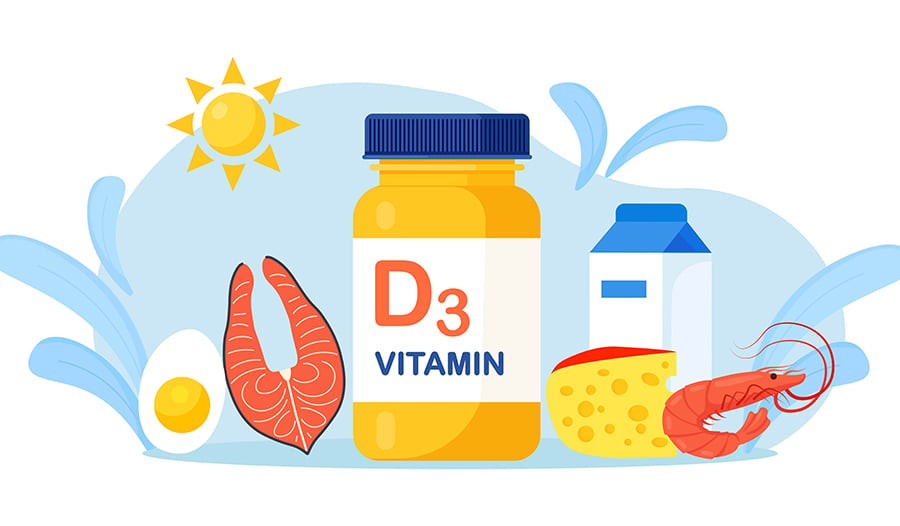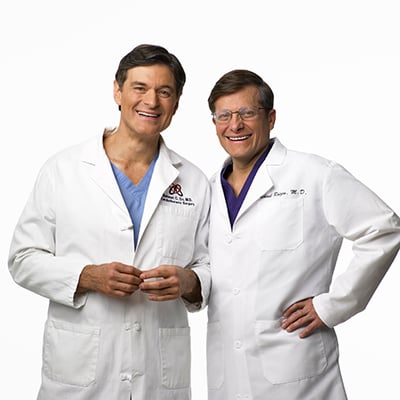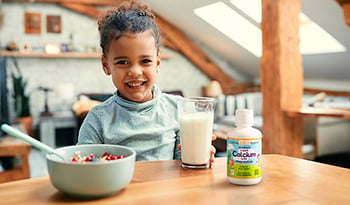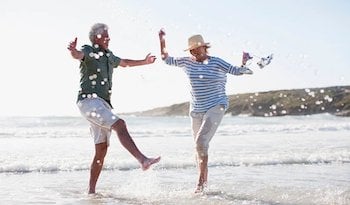Vitamin D’s Dynamic Benefits
DISCLAIMER:This blog does not intend to provide diagnosis...
- In this article:
- The Dangers of Vitamin D Deficiency
- The Benefits of Boosting Vitamin D
- How To Get More Vitamin D
- Vitamin D Rich Harissa Salmon Filet Recipe

Overall, over 40% of Americans are vitamin D deficient—and among those with darker skin, it skyrockets to more than 80%. That’s because we live such indoor lives—and only around 10% of the active vitamin D we get comes from foods we eat. The rest gets activated, or doesn’t, from exposure to sunlight, and darker skin does not let enough energetic UV rays through to stimulate the precursor to active vitamin D.
The Dangers of Vitamin D Deficiency
Often a D-ficiency is accompanied by health problems such as obesity, high blood pressure, and low levels of good-for-you HDL cholesterol. The list of health issues that can develop with a chronic lack of vitamin D is long and potentially devastating.
Vitamin D deficiency is associated with bone and muscle pain weakness and increased risk of falls in older adults. In addition, a 14-year Chinese study shows that folks with prediabetes (almost 100 million Americans) and lower blood levels of vitamin D were far more likely to progress to type 2 diabetes than those with healthy levels of D—and if their triglyceride levels were also elevated, the risk was even greater. Another study shows a cluster of risk factors that are associated with developing dementia at a young age, including a lack of vitamin D. There’s even a correlation between a vitamin D deficiency and shin splints, according to researchers at the Cleveland Clinic. And we haven’t even mentioned the risk of cardiovascular and autoimmune disease and increased vulnerability to infection.
The Benefits of Boosting Vitamin D
The far-reaching benefits of vitamin D come in part from the fact that once it is activated by your liver and kidneys, it becomes, in actuality, a hormone called calcitriol.
In your body, activated vitamin D helps increase the absorption of calcium so it can enter your bloodstream, helps prevent calcium loss from the kidneys, and promotes the formation of new bone cells. It also plays an important role in bolstering your immune system, pushing calories into muscle rather than fat, countering depression and heart disease, and, yes, helping prevent the progression of prediabetes to full-blown type 2 diabetes.
Plus, getting your vitamin D from exposure to morning sunlight confers special benefits to folks trying to achieve a healthy weight. One study in the journal Cell found two kinds of fat cells that provide energy to the body and are regulated by light exposure. The researchers concluded that getting a dose of morning sunlight may shrink fat cells below the skin, promoting weight loss. In another study, women 65+ with higher vitamin D levels were less likely to gain weight. A study in PLOS One, looking at the impact of early-in-the-day light exposure on weight, found a 34% difference in weight between folks with regular early light exposure and those with little or late-day exposure.
How To Get More Vitamin D
Tune into the power of 10-30 minutes of sunlight daily to help you achieve a healthy level of vitamin D. The rest of the day, wear sunscreen with an SPF of 35 and sunglasses to reduce the risk of skin cancer and cataracts. But what can you do if you need extra help to boost your vitamin D levels? Check out researched benefits of vitamin D supplements.
You can also boost your D with D-licious wild-caught salmon—and other vitamin D rich-foods.
Vitamin D Rich Harissa Salmon Filet Recipe
PREP: 15 minutes
COOK: 12 minutes
MAKES: 2 servings
SERVING SIZE: Two 3-ounce fillets
- Calories: 425 kcal
- Total fiber: 2.7 g
- Soluble fiber: 0.3 g
- Protein: 35.4 g
- Total fat: 28.3 g
- Saturated fat: 4.1 g
- Healthy fats: 15.8 g
- Carbohydrates: 5.8 g
- Sugars: 0.5 g
- Added sugars: 0g
- Sodium: 606 mg
- Potassium: 670 mg
- Magnesium: 45 mg
- Calcium: 106 mg
In this recipe, healthy king salmon showcases the North African flavors of harissa. The Harissa Spice Blend is on the mild side because everyone has a different tolerance for spice, but don’t be afraid to increase the chili pepper in this dish—the salmon’s richness and fat content soothe the heat and create a harmonious balance.
Ingredients:
- 1 tablespoon fresh Italian parsley, finely chopped, plus more for garnish
- 1 tablespoon extra-virgin olive oil
- 3 garlic cloves, finely chopped
- 1 tablespoon Harissa Spice Blend (see below)
- 1½ teaspoons (packed) lemon peel, finely grated
- 1 teaspoon fresh lemon juice
- ¼ teaspoon kosher salt
- ⅛ teaspoon freshly ground black pepper
- 4 skinless wild salmon fillets (3 ounces each), preferably king salmon
To Prepare
- Preheat the oven to 350°F. In a small bowl, combine 1 tablespoon parsley with olive oil, garlic, Harissa Spice Blend, lemon peel and juice, salt, and pepper. Stir until well blended. Spread a quarter of the harissa mixture (about 2 teaspoons) evenly over the top of each salmon fillet.
- Spray a 12-by-8-inch rimmed baking sheet with nonstick coating. Place the fillets about an inch apart on the prepared sheet. Roast the salmon until the fillets feel almost firm to the touch and are just cooked through, about 12 minutes.
- Garnish the fillets with some chopped parsley before serving.
Harissa Spice Blend Recipe
Ingredients:
- 2 teaspoons caraway seeds
- ½ teaspoon red chili flakes
- 1 teaspoon kosher salt
- 4 teaspoons paprika
- 1 tablespoon smoked paprika
- 1 tablespoon ground cumin
- 2 teaspoons garlic powder
- 1 tablespoon ground cumin
- 2 teaspoons garlic powder
1. Finely grind the caraway seeds and chili flakes in a mortar and pestle or in a spice grinder. Add the salt and blend 10 seconds. Transfer the blend to a small container.
2. Mix in the remaining ingredients. Cover and store at room temperature or in the refrigerator for up to 2 months.
References:
- Forrest KYZ, Stuhldreher WL. Prevalence and correlates of vitamin D deficiency in US adults. Nutrition Research. 2011;31(1):48-54. doi:https://doi.org/10.1016/j.nutres.2010.12.001
- Yale Medicine. Vitamin D Deficiency. Yale Medicine. Published 2023. https://www.yalemedicine.org/conditions/vitamin-d-deficiency
- Vitamin D status, vitamin D receptor polymorphisms, and risk of type 2 diabetes: A prospective cohort study | The Journal of Clinical Endocrinology & Metabolism | Oxford Academic (oup.com)
- Centers for Disease Control and Prevention. National diabetes statistics report. CDC. Published November 29, 2023. https://www.cdc.gov/diabetes/data/statistics-report/index.html
- Hendriks S, Ranson JM, Peetoom K, et al. Risk Factors for Young-Onset Dementia in the UK Biobank. JAMA Neurology. Published online December 26, 2023. doi:https://doi.org/10.1001/jamaneurol.2023.4929
- Shin Splints: Symptoms, Causes & Treatments (clevelandclinic.org)
- Wang H, Chen W, Li D, et al. Vitamin D and Chronic Diseases. Aging and disease. 2017;8(3):346. doi:https://doi.org/10.14336/ad.2016.1021
- Fleet JC. The role of vitamin D in the endocrinology controlling calcium homeostasis. Molecular and Cellular Endocrinology. 2017;453:36-45. doi:https://doi.org/10.1016/j.mce.2017.04.008
- Nayak, Gowri, et al. Adaptive Thermogenesis in Mice Is Enhanced by Opsin 3-Dependent Adipocyte Light Sensing. Cell Reports. Volume 30, Issue 3, 2020. Pages 672-686.e8, ISSN 2211-1247, https://doi.org/10.1016/j.celrep.2019.12.043.
- Subcutaneous white adipocytes express a light sensitive signaling pathway mediated via a melanopsin/TRPC channel axis | Scientific Reports (nature.com)
- LeBlanc ES, Rizzo JH, Pedula KL, et al. Associations Between 25-Hydroxyvitamin D and Weight Gain in Elderly Women. Journal of Women’s Health. 2012;21(10):1066-1073. doi:https://doi.org/10.1089/jwh.2012.3506
- Reid KJ, Santostasi G, Baron KG, Wilson J, Kang J, Zee PC. Timing and Intensity of Light Correlate with Body Weight in Adults. Mistlberger RE, ed. PLoS ONE. 2014;9(4):e92251. doi:https://doi.org/10.1371/journal.pone.0092251

 By Dr. Mehmet Oz, M.D. and Dr. Michael F. Roizen, M.D.
By Dr. Mehmet Oz, M.D. and Dr. Michael F. Roizen, M.D.


